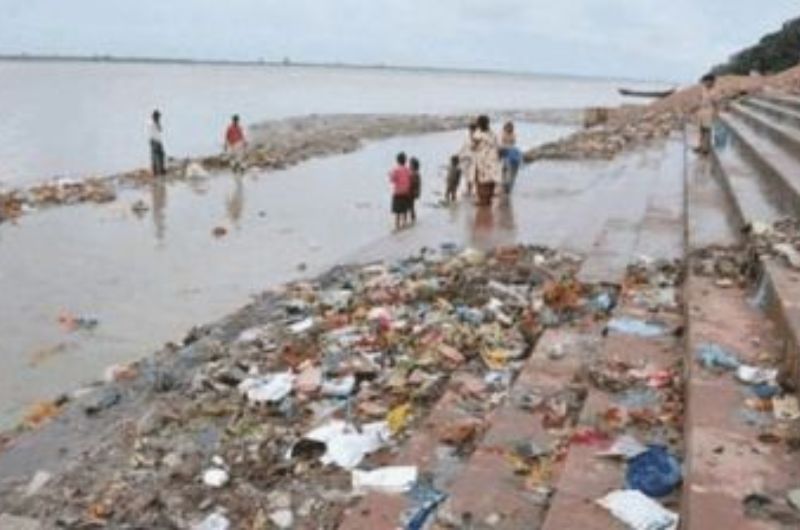Bharat Dogra paints a grim picture of the fallout of what many consider counter productive efforts under the Namami Gange programme to protect the Ganga
The much-hyped Namami Gange Project has committed Rs 20000 crore to the protection of the River Ganga. Yet, it has been significantly unsuccessful. Data available from Varanasi, a highly-publicised spot in the project, reveals that the parameters of acceptable water quality for bathing are yet to be met there. Why has the project remained unsuccessful?
The answer lies partly in the fact that around one-third of the sanctioned funds were not released – in some years, the shortfall was higher. But clearly, even in terms of the limited amounts spent, the achievement is much less than expected.
Perhaps no other organisation has monitored the water quality of the Ganga so consistently and sincerely as the Sankatmochan Foundation (SF) in Varanasi. It is known for its constructive role and innovative work on reducing river pollution and also has a spiritual slant, deeply rooted in the social harmony and heritage of Varanasi. Ideally, such an organisation should have been given a lead role by the government in the protection measures but, instead, the political power system preferred the technocratic, expensive, big business-oriented approach which experience has shown to be not very effective.
The Matri Sadan, another body focused on the spiritual facets of the river in the Himalayan reaches, has been at odds with the ruling party in both the state (Uttarakhand) and the Centre. Some leading members of theMatri Sadan have sacrificed their lives for the cause by undertaking fasts of upto 100 days. These include Prof G.D. Aggarwal, who took a doctorate from the US, taught at an IIT and went on to become a top pollution control official of India before giving it all up to join the Sadan and devote himself to the protection of the Ganga.
Due to the professor’s scientific learning and stature, he could have dialogues with the senior-most government functionaries on the flaws in their approach to the protection of the river. He and other saints of Matri Sadan raised serious objections to excessive dam construction, indiscriminate mining and other ecologically destructive activities. When their pleas were not heard, they sacrificed their lives by undertaking long fasts.
Ravi Chopra is another well-known engineer and expert on Ganga and Himalayan ecology (Prof Aggarwal was his teacher and mentor), respected for his sincerity and scholarship. He was frequently appointed to high-level committees, particularly those set up at the initiative of the Supreme Court. He recently resigned from one such committee as the views of ecologists on road construction and planning relating to saving trees, forests and farms and preventing landslides and disasters were being ignored.
The task of protecting forests and biodiversity in catchment areas of the Ganga (or any other river) is integral to river protection, and a committee on the 2013 floods in the Himalayan Region, set up at the initiative of the Supreme Court and chaired by him, found that critical catchment protection projects were way behind schedule. Many such knowledgeable people committed to protecting the Ganga feel the protection of the river and its catchment areas is neglected by the ruling party and are unhappy with the present state of affairs.
Reports prepared by senior Gandhian social activists of Uttarakhand, including Suresh Bhai and Radha Bhatt, reveal that tens of thousands of trees are in danger of being cut in highly eco-sensitive areas while a large number have been cut already. They point out that felling of even one tree carelessly on these slopes damages several other trees as well. What is more, the massive quantities of rubble and debris generated in the process of cutting hills for indiscriminate construction work is finding its way into the river and its tributaries. The entire process is making the disaster-prone region even more prone to landslides and floods.
It has been a long-standing demand of environmentalists, particularly those involved closely with the protection of the Ganga, that ecologically disruptive hydel projects in the Himalayan areas through which the river and its tributaries traverse be avoided. Unfortunately, the Union Government has not been sensitive to this demand of late. In fact, even the easier-to-accept demands of checking mining activities in and around the main river and its tributaries did not get adequate attention.
Now, the ecological problems and vulnerability to disasters are likely to worsen because of the large-scale felling of trees. Thousands of trees, particularly deodar, in the most sensitive and sacred Uttarkashi-Gangotri stretch are threatened even now. Deforestation, rapid biodiversity loss and indiscriminate dam construction have adverse impacts on water quality too.
In addition, there has been significant failure in reducing domestic and industrial pollution. The emphasis has remained on more expensive, energy-intensive sewage treatment plants which often function much below capacity at the cost of simpler, cheaper, more innovative and participatory, decentralised approaches to reducing pollution. Additional ecological threats are posed by ongoing ambitious plans for river transport.
Work on beautifying the ghats is more of cosmetic importance, and many in Varanasi believe that much of the associated demolitions were avoidable. These demolitions are also linked with the loss of livelihood and there have been complaints that the traditions and heritage of the city are being ignored while taking up the so-called beautification work. The livelihoods of weavers and craftpersons of Varanasi and nearby areas cannot be neglected in the mainstream discourse on Ganga and Varanasi.
The wider reality is that the Union Government lacks a proper, comprehensive vision of what constitutes protection of rivers and river-systems, which in turn has resulted in disruptive schemes like national river linkages, despite experts, including former senior government officials, highlighting the adverse fallouts of such schemes The situation has led to the alienation of who can help the most in mobilising people for Ganga protection.
April – June 2022



 from Webdoux
from Webdoux